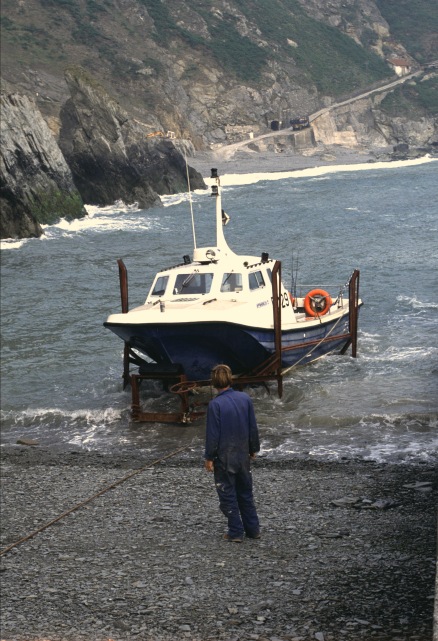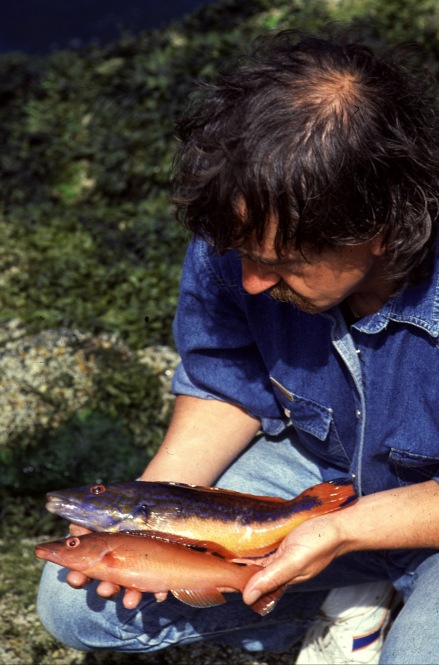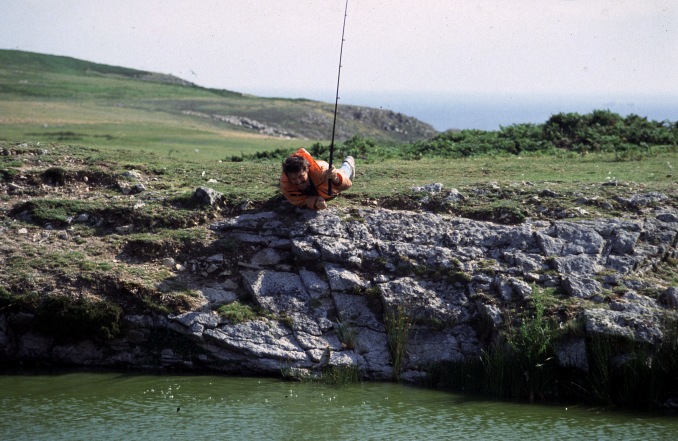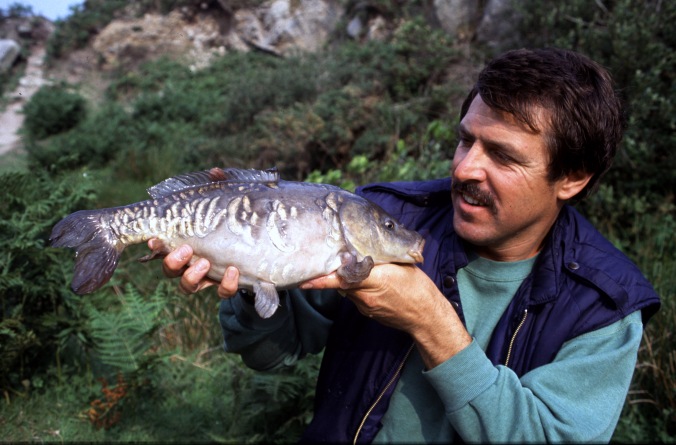Lundy Island

Despite being no more than a dozen or so miles out in the Bristol channel off the north coast of Devon, to most people Lundy Island is still an enigma. At around 3 miles long by half a mile wide with sheer cliffs virtually all the way round this peat topped lump of granite, it is almost certainly the most isolated and least venue known in England. And yet it is inhabited by workers employed by the Landmark Trust who manage this unique piece of wildlife heritage on behalf of English Nature. The waters around Lundy are now England's only statutory marine reserve, with angling excluded from specified areas, and all fishing except for angling and potting prohibited in the rest of the reserve. Anchoring is discouraged and even banned in some areas to preserve this pristine environment which contains animals so rare in UK waters that protection is vital. And as you can well imagine, it is also a haven for fish and a potential haven for anglers. But few people ever get to fish these waters, and even fewer using the island as a base.
Some years ago, Graeme Pullen and myself received an invite to base ourselves on the island for the best part of a week to explore the fishing. Some of this would be shore based. But we were also given access to the islands own launch, an Offshore 32, which when it was not working, weather permitting would take us fishing. In particular we wanted to drift the tide rips at both ends of the island for porbeagle sharks, something which the weather was to kill stone dead. So bad was the wind that the 'MV Oldenberg' which takes visitors across from Illfracombe had to abandon its attempt as it would not have been possible to put them ashore using launches as the sea was too rough. Lundy has no landing or safe mooring. The Offshore 32 has to be trailered using a big drum winch and steel cables after every trip, and left below the steep cliffs in a small gravel cove sheltered by Rat Island. Our first sighting of her however was in the middle of the Bristol Channel when she was sent out to meet the 'Oldenberg', take us off, and ferry us ashore.

Shore Fishing
To get an idea of what it Lundy is like, you have first to understand that the island is covered in peat and little in the way of other vegetation with a few goat tracks here and there. Apart from a small cluster of buildings, the odd accommodation, and a light house, thats pretty much it. No roads; no nothing. And every shore fishing platform is at the bottom of a steep cliff. Ballan wrasse had been our theoretical target fish. I'd read fanciful stories of the biggest ballan wrasse in Britain being there, probably written by people who had never wetted a line on the place. Make no mistake about it, this is prime ballan wrasse territory. But from our experiences, these fish were probably not going to prove anything out of the ordinary. We certainly saw no signs of fish in excess of 4 pounds, though in fairness, we didn't have much in the way of suitable bait as we'd gone primarily to shark fish, and had taken little in the way of bait with us. And there was no chance of collecting any once there. Mackerel and limpets were plentiful, But that was it.

Mixed amongst the ballan's were a lot of cuckoo wrasse, the males of which looked pretty spectacular. We also had a few sessions lure fishing from various rock ledges and the base of the lighthouse where small redgills in particular picked up some half decent pollack. But again, nothing to get too excited about. Most of the excitement if you can call it that came from getting down the cliffs to wet a line. I've no head for heights, so I found it particularly worrying. But we got down to pretty much every mark we intended to try and gave each ample fishing time as the wind was pretty relentless, even on the one day we decided to say 'sod it', if we don't brave it today, we are going to miss out altogether. A day when with the benefit of hindsight, we perhaps ought not to have gone out.
Boat Fishing
The wind as I remember it was coming from the east which put the boat launch side of the island pretty much straight into the teeth of it. Both tide rips were also catching it, with lots of white water to mark their presence. But out around the other side of the island it was flat calm in the lee of the cliffs, and with a nice steep sand bank not too far from shore, plus some good reefs to at towards the top of the island, temptation finally got the better of us. If only we could get to the sheltered side. But that would mean negotiating one of the tide races which we didn't fancy having to do. The obvious one to go for was the bottom one out past Rat Island as it would be the quickest to get to in the lumpy conditions. Anyway, on the last day we decided to go for it, and needless to say survived or these words would not be appearing here. But it was hairy, though there was an even hairier ordeal yet to come.
The reef produced lots of pollack and coalfish. Drifting the bank with long flowing traces baited with long thin belly cuts of fresh mackerel was much more interesting. This produced turbot, blonde and small eyed rays. The only problem was that instead of leaving the engine running while we drifted, it was switched off. These drifts would take us up out of the shelter of the cliffs right up to the edge of the nasty stuff. Except on one occasion, the engine refused to fire up. Very quickly we were out of the lee and right in the thick of it along the tide race. Try as we may, she wouldn't fire up again. We had Swansea standing by. Then I remembered that I had put a car battery on the boat some days earlier to power the video camera. Just in case it was a dud battery we decided to give it a go. I remember being stood below deck level working on the thing and seeing grey lumps of water towering above the gunnel's rolling by. It was real bowel clearing stuff. But I can also recall the feeling of euphoria when the engine did actually fire up allowing us to start gingerly picking our route back to shelter.


Freshwater Fishing
While hiking back from a wrasse fishing session over on the far side of the island, we came across a deep craggy hole filled with pea green water. The water obviously had to be fresh, and the discolouration looked like it was caused by algae. As we passed it, we noticed small bulges in the waters surface that looked as if they'd been made by of fish. Curious to know if it was fish, and if so what species, but not exactly tooled up for the job with shore angling outfits, limpets and mackerel for bait, we each decided to dangle a different bait in the water to see what reaction it might draw, and yes they were fish. In fact they were carp, and anything even remotely edible was going to be eaten the instant it entered the water, as they were otherwise pretty much reliant on visitors feeding them with bread.
The following morning we held back on the bread rolls at breakfast time, borrowed a wicker rubbish bin lined with a plastic bag from the room to act as keep net, and tied one end of a short length of the finest nylon we could muster to the end eye of our uptiders, and the other to the smallest hooks we could find. Then off we went carp fishing Lundy style. To say we had a good session would be something of an understatement. In truth, we probably could have emptied the place. The only problem was that they were all pretty much the same size, which you can no doubt imagine would be quite small.
Chatting about this to the locals that evening in the bar, one of them told us of a second, larger pond and gave us its location. This one was several times bigger and had a few shrubs around its peaty margins which made it look a little more like a carp water. We used the same gear and tactics. We had to as we had little other choice. But these weren't met with the same response. The carp were just as willing to feed, but they were of a much better stamp. Graeme even manged one a shade over five pounds. Golder orfe were also there and in hungry mood. And we had another carp species - the prussian carp. Obviously all had been imported to the island and introduced. But for what reason and by who